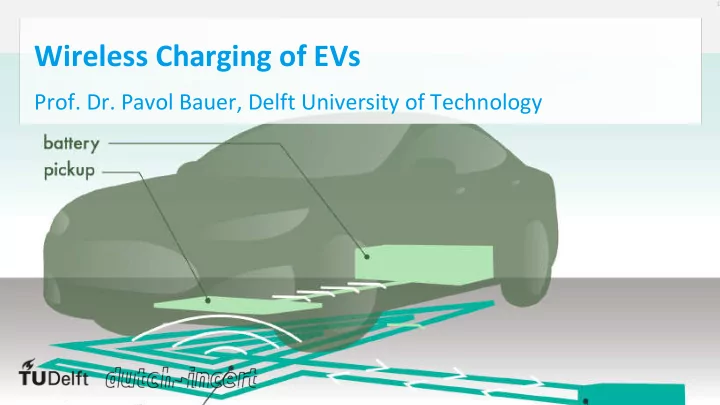

Wireless Charging of EVs Prof. Dr. Pavol Bauer, Delft University of Technology
Learning objectives 1. What are the advantages and disadvantages of wireless charging? 2. What are the parts of an inductive wireless charging system? 3. How does an inductive power transfer system work?
Wireless Power Transfer Modes • Transfer of energy without wired interconnects. • Different types of wireless power transfer techniques based on energy carrier medium: Inductive (Inductive power transfer or IPT) § Capacitive § Microwave § Laser § Acoustic §
Today: Static Inductive Charging Advantages Disadvantages Aesthetically favorable, no 5-10% higher losses vandalism Higher costs compared Safety Image source: Plugless power to AC, DC charging Extra converters Comfort compared to AC charging
Inductive Power Transfer - Components Traction motor Electric Vehicle Secondary Compensation Battery Regulator Rectifier DC DC DC AC M DC DC /Rectified AC DC Input Primary Inverter Compensation
Materials in Charge-pads 1. Current conducting materials 2. Magnetic flux channelling materials 3. Magnetic flux shielding Ferrite bars Copper materials conductor Al shield
Charge-pads in Practice
Wireless charging while driving Charging pad in the road generating a EV power pick-up magnetic field charge pad
On-road charging of EVs Convenience • Smaller batteries on EVs • High cost of multiple charge pads • and power electronic converters Misalignment between coils • Standardisation amongst EVs • Charging pad in the road generating a EV power pick-up magnetic field charge pad
Wireless Charging of EVs Prof. Dr. Pavol Bauer, Delft University of Technology
Coefficient of Coupling and Mutual Inductance L 1 , L 2 are the inductances of the primary, secondary coils • |k| = 0.01–0.5 (loosely coupled), |k| = 0.9-1 (tightly coupled) • i 1 i 2 k ! "# = ! " − & ! '# = ! ' − & L 1 L 2 e 1 e 2 V 1 R L & = ( ! " ! '
Coefficient of Coupling and Mutual Inductance C 1 L 1 -M L 2 -M C 2 + I 2 I’ 1 I m V 1 R L,eq M E 2 - i 1 i 2 Equivalent load k circuit model ! "# = ! " − & L 1 L 2 e 1 e 2 V 1 R L & = ( ! " ! ' ! '# = ! ' − &
Equivalent Circuit of IPT System Traction motor C 1 L 1 -M L 2 -M C 2 Electric Vehicle + I 2 I’ 1 I m Battery Regulator Rectifier V 1 R L,eq E 2 M DC Secondary Compensation DC - M Equivalent load DC circuit model DC /Rectified DC AC i/p Primary VLF-LF Inverter Compensation
Need for Compensation • Due to large leakage inductances – Poor efficiency (loss α # , ). • Compensate leakage inductance with capacitances L 1 -M L 2 -M C 1 L 1 -M L 2 -M C 2 I 2 + + I 1 I 2 I’ 1 I m I m V 1 R L,eq V 1 M E 2 R L,eq M E 2 - - # " cos θ ! " ! #′ " " θ P = ! " # " cos θ Θ = 0 * P = ! " #′ " # " #′ " < # "
Reactive Power Exchange in Inductors
Recommend
More recommend